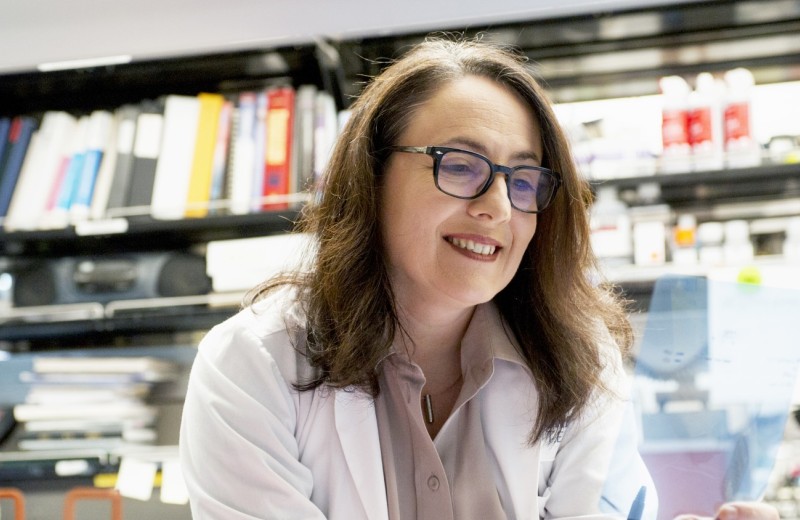Gladstone NOW: The Campaign Join Us on the Journey✕

Researchers in the laboratory of Steven Finkbeiner, PhD, discovered a single enzyme that regulates progranulin, a protein that may contribute to Alzheimer’s disease and frontotemporal dementia. [Photo: Chris Goodfellow, Gladstone Institutes]
Scientists at the Gladstone Institutes scored a rare two-for-one gain by discovering an enzyme that controls the levels of a protein implicated in both Alzheimer’s disease and frontotemporal dementia.
“For some time, we have known that low levels of the protein progranulin are associated with these two forms of dementia and that increasing levels improves deficit in animal models of the two diseases,” said Steven Finkbeiner, MD, PhD, a senior investigator at Gladstone. “But how could we use that as a possible therapy? That’s what is exciting about our latest results.”
In a new study published in the Journal of Biological Chemistry, Finkbeiner’s team looked closely at progranulin, which is secreted from cells and controls inflammation. Having only one copy of the gene for progranulin causes frontotemporal dementia, the most common form of dementia in people under age 65, while having mutations in the progranulin gene is a risk factor for developing Alzheimer’s disease. Both conditions result in lower levels of progranulin in the brain.
“We wanted to know what might regulate the levels of progranulin,” said Amanda Mason, a former PhD student in Finkbeiner’s lab and lead author on the study. “Many processes in biology are controlled by adding or removing a small chemical group called phosphate, so we started there.”
The team used a genetic method to look for enzymes that help to remove phosphate groups in mice. Surprisingly, among the enzymes they found, one—serine/threonine protein kinase 1, or Ripk1 for short—increased the levels of progranulin inside and outside of the cells. The real bonus was that Ripk1 worked in mouse models of both Alzheimer’s disease and frontotemporal dementia. Interestingly, the effect did not depend on the removal of the phosphate groups from progranulin, which implies that the effect comes about through a nonenzymatic mechanism.
“This is an exciting finding,” said Finkbeiner. “Alzheimer’s disease was discovered over 100 years ago, and we have essentially no drugs to treat it. To find a possible new way to treat one disease is wonderful. To find a way that might treat two diseases is amazing.”
Support Discovery Science
Your gift to Gladstone will allow our researchers to pursue high-quality science, focus on disease, and train the next generation of scientific thought leaders.
Gladstone’s Scientific Highlights of 2025
Gladstone’s Scientific Highlights of 2025
From fundamental insights to translational advances, here’s how Gladstone researchers moved science forward in 2025.
Gladstone Experts Alzheimer’s Disease Autoimmune Diseases COVID-19 Neurological Disease Genomic Immunology Cardiovascular Disease Data Science and Biotechnology Infectious Disease Conklin LabScience in Seconds | The Thinking Microscope: Research Powered by an AI Brain
Science in Seconds | The Thinking Microscope: Research Powered by an AI Brain
In this video, Steve Finkbeiner and Jeremy Linsley showcase Gladstone’s groundbreaking “thinking microscope”—an AI-powered system that can design, conduct, and analyze experiments autonomously to uncover new insights into diseases like Alzheimer’s, Parkinson’s, and ALS.
Gladstone Experts ALS Alzheimer’s Disease Parkinson’s Disease Neurological Disease Finkbeiner Lab AI Big DataKaterina Akassoglou Receives Zenith Fellows Award to Advance Alzheimer’s Research
Katerina Akassoglou Receives Zenith Fellows Award to Advance Alzheimer’s Research
Akassoglou has opened doors to understanding how the blood protein fibrin is involved in Alzheimer’s and other neurodegenerative diseases.
Awards News Release Alzheimer’s Disease Center for Neurovascular Brain Immunology Akassoglou Lab




